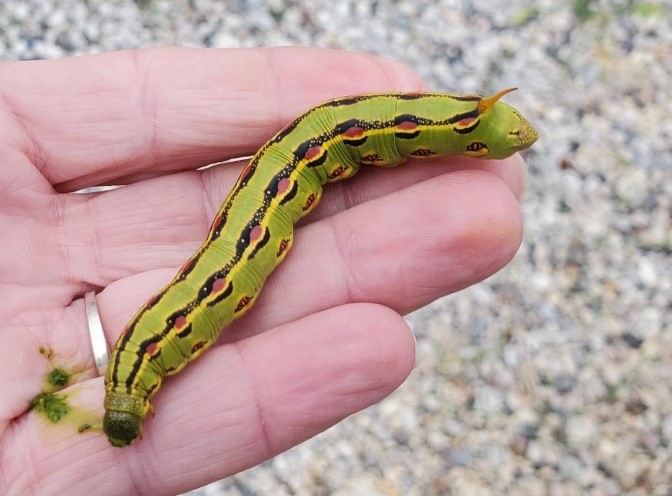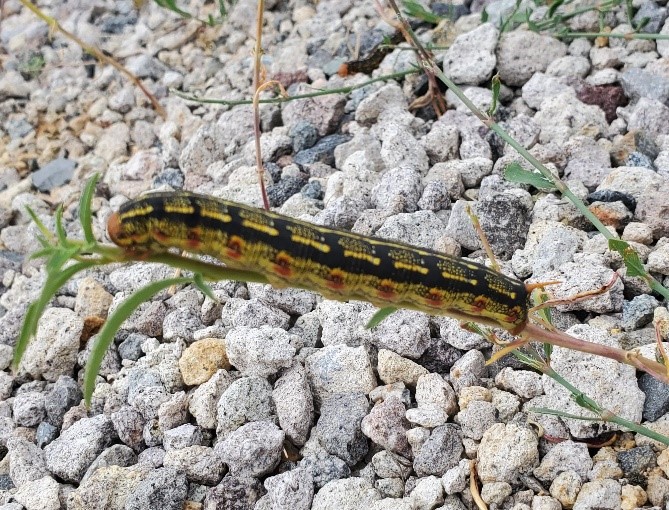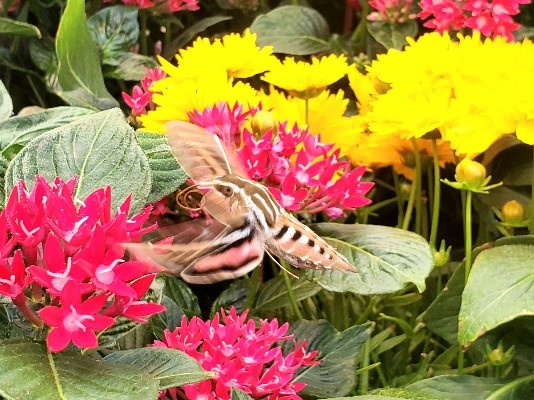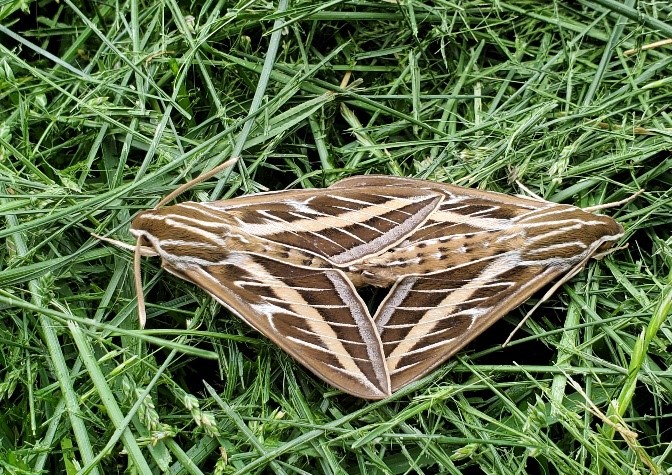Common names: White-lined sphinx moth, hummingbird moth
Scientific name: Hyles lineata
Description:
Adult moths have beautiful brown wings with thick tan lines across the wings and white lines flowing through the brown and tan band. The hindwings are bright pink. The adults are often seen hovering over flowers and darting from one flower to another, similar to a hummingbird. The caterpillars come in a variety of colors depending on the climate and weather. Both have a horn on their back end. Two different varieties of caterpillars can be seen on the left-hand side.
 White-lined caterpillar (green variety). Photo by Wendy Hanson Mazet.
White-lined caterpillar (green variety). Photo by Wendy Hanson Mazet.
 White-lined caterpillar (green variety). Photo by Wendy Hanson Mazet.
White-lined caterpillar (green variety). Photo by Wendy Hanson Mazet.
Behavior:
Like hummingbirds, adult moths can be seen hovering around flowers as they use their long proboscis (sucking mouthpart) to drink the flowers’ nectar. Occasionally, caterpillars are present in incredibly large numbers and will move in groups to look for food.
Life cycle:
There are typically two generations of moths per year. When caterpillars are ready to pupate, they dig shallow burrows into the ground, where they will stay for two to three weeks before emerging as adult moths. Adult moths are most commonly seen at dusk or dawn. In the spring, females lay eggs on various plants, which the caterpillars will then eat. Adults typically live for one to two weeks.
 White-line sphinx moth pupa. Photo by Wendy Hanson Mazet.
White-line sphinx moth pupa. Photo by Wendy Hanson Mazet.
Diet and damage:
Caterpillars feed on a large variety of plant parts, including the leaves, green fruits and even stems. Caterpillars in large numbers are capable of wiping out a whole field of plants; however, just a couple of caterpillars are best to leave alone as they can be beneficial in promoting bird and reptile populations. Caterpillars will consume elderberries, evening primrose, fuchsia, grape, lilac, rose and willowherbs. Adults feed on the nectar of plants and do not cause any damage. In addition, it is important to note that adults are important pollinators to many of our plants.
Monitoring:
Regular monitoring of plants is key to protecting plants from caterpillar damage. Routinely check leaves and stems for egg masses or caterpillars if you are seeing damage to your plants. Help with identification is available by contacting your local Extension office.
 Adult White-lined sphinx moth eating nectar from a flower.
Adult White-lined sphinx moth eating nectar from a flower.
 Adult White-lined Sphinx moths mating. Photo by Wendy Hanson Mazet.
Adult White-lined Sphinx moths mating. Photo by Wendy Hanson Mazet.
Cultural control:
White-lined sphinx moths often do not cause mass damage to crops or ornamentals; however, if they have run out of other food sources, damage may be more severe. It is important to assess the amount of damage being done and determine whether or not control is necessary. Tilling soil before winter can reduce next year’s population by up to 90% by removing the soil-dwelling pupae. In addition, creating borders around gardens of native flowers and plants will promote habitat for predators and parasitoids, which naturally help reduce the moth population.
Mechanical control:
Garden hoops, tunnels and row covers can also reduce damage to plants as long as they are put up before eggs are laid in the spring. Removing caterpillars from plants and eradicating them will dramatically reduce populations but it can be labor intensive. When searching plants, the use of a UV blacklight can be beneficial as it will make the caterpillars glow at night making them easy to identify.
Biological control:
Birds and bats are common predators of caterpillars. Parasitoid wasps and flies will attack live caterpillars and use them as a food source. Other beneficial insects, such as true bugs, spiders and wasps, will attack the caterpillars as well. Having a healthy ecosystem can help control populations of sphinx caterpillars.
Chemical control:
Moths should only be treated with insecticides if infestations are incredibly damaging. Chemicals used to control these moths will affect other beneficial insects. When applying a pesticide, read the entire product label thoroughly before application.


